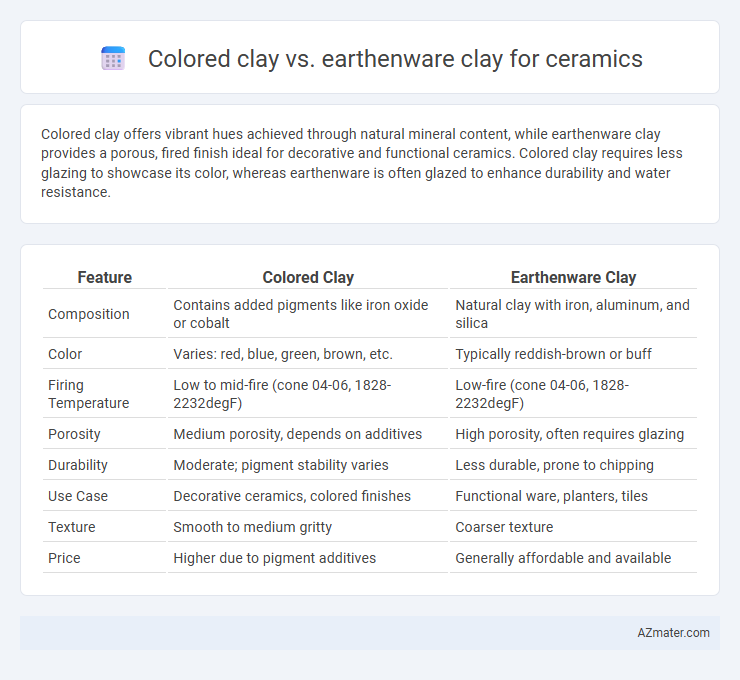Colored clay offers vibrant hues achieved through natural mineral content, while earthenware clay provides a porous, fired finish ideal for decorative and functional ceramics. Colored clay requires less glazing to showcase its color, whereas earthenware is often glazed to enhance durability and water resistance.
Table of Comparison
| Feature | Colored Clay | Earthenware Clay |
|---|---|---|
| Composition | Contains added pigments like iron oxide or cobalt | Natural clay with iron, aluminum, and silica |
| Color | Varies: red, blue, green, brown, etc. | Typically reddish-brown or buff |
| Firing Temperature | Low to mid-fire (cone 04-06, 1828-2232degF) | Low-fire (cone 04-06, 1828-2232degF) |
| Porosity | Medium porosity, depends on additives | High porosity, often requires glazing |
| Durability | Moderate; pigment stability varies | Less durable, prone to chipping |
| Use Case | Decorative ceramics, colored finishes | Functional ware, planters, tiles |
| Texture | Smooth to medium gritty | Coarser texture |
| Price | Higher due to pigment additives | Generally affordable and available |
Introduction to Colored Clay and Earthenware Clay
Colored clay features natural or added pigments that provide vibrant hues, enhancing the aesthetic appeal of ceramics without the need for glazing. Earthenware clay is a porous, low-fire clay type that is typically reddish-brown due to its iron content and requires glazing to achieve water resistance and varied finishes. Both clays offer unique textural and color characteristics, making them popular choices for artistic and functional ceramic projects.
Composition and Material Differences
Colored clay contains natural or synthetic pigments mixed into the base material, offering vibrant hues without glazing, while earthenware clay is primarily composed of natural iron-rich minerals that yield warm reddish or brown tones after firing. The mineral composition of colored clay is tailored to maintain consistent color throughout the ceramic body, whereas earthenware clay's porous structure and iron oxide content make it more absorbent and susceptible to color variation. These differences in material makeup affect firing temperature, durability, and final surface finish during the ceramic production process.
Color Options and Visual Effects
Colored clay offers a vibrant palette with built-in pigments, allowing artists to achieve consistent hues and intricate color patterns directly in the ceramic body. Earthenware clay typically has a natural reddish-brown base that can be altered through glazes or surface treatments, providing subtle earthy tones and varied visual textures. Selecting colored clay enhances color stability throughout firing, while earthenware clay emphasizes organic, rustic aesthetics with opportunities for layered glaze effects.
Workability and Handling Properties
Colored clay offers enhanced visual appeal while maintaining smooth workability, making it ideal for detailed ceramic projects. Earthenware clay typically exhibits a coarser texture and higher porosity, requiring more careful handling to prevent cracking during shaping and drying. Both clays respond well to wheel throwing, but colored clay often provides greater plasticity and ease in achieving fine details.
Firing Temperatures and Kiln Requirements
Colored clay typically matures at mid-range firing temperatures between Cone 04 (1940degF/1060degC) and Cone 6 (2232degF/1222degC), requiring oxidation kilns to preserve its vivid hues. Earthenware clay matures at lower temperatures around Cone 06 to Cone 02 (1828degF to 2012degF/998degC to 1100degC) and can be fired in electric kilns with oxidation, but often needs glazing due to its porous nature. Understanding these firing ranges and kiln atmospheres ensures optimal durability and color retention for ceramic projects.
Durability and Functional Strength
Colored clay often contains added pigments and minerals that can impact its durability, making it suitable for decorative ceramics but sometimes less strong than pure earthenware clay. Earthenware clay, known for its porous nature and lower firing temperature, generally offers moderate durability and functional strength but requires glazing to enhance water resistance and toughness. For applications demanding higher durability and functional strength, earthenware clay combined with appropriate glazing provides a more reliable option than most colored clays.
Artistic Techniques and Decorative Possibilities
Colored clay offers unique artistic techniques through its inherent pigmentation, allowing artists to create multicolored works without surface glazing, enhancing decorative possibilities with marbling, inlay, and layering methods. Earthenware clay, typically porous and white or red, excels in surface treatments such as glazing, painting, and carving, enabling rich textural and color contrasts after firing. Combining colored clay with earthenware expands creative boundaries by blending intrinsic hue variations with versatile surface decoration techniques.
Cost Comparison and Accessibility
Colored clay generally incurs higher costs than earthenware clay due to the inclusion of pigments and specialized processing, making it less accessible for beginners or large-scale projects. Earthenware clay remains more affordable and widely available, favored for its easy sourcing and suitability for everyday pottery and ceramics. Budget-conscious artists and educators often choose earthenware clay to maximize cost-efficiency without sacrificing versatility.
Environmental Impact and Sustainability
Colored clay often contains synthetic pigments that can introduce non-biodegradable substances and heavy metals, increasing its environmental footprint compared to natural earthenware clay. Earthenware clay is typically sourced locally with minimal processing, reducing transportation emissions and energy use, making it a more sustainable option for ceramics. The biodegradable properties and natural composition of earthenware contribute to lower environmental impact throughout the lifecycle of ceramic products.
Choosing the Right Clay for Your Ceramic Project
Colored clay offers inherent pigmentation, reducing the need for surface glazing and allowing for vibrant, unique finishes in ceramic projects. Earthenware clay, known for its porous and low-temperature firing properties, provides excellent workability and is ideal for decorative pottery and functional ware requiring a rustic aesthetic. Choosing between colored clay and earthenware depends on desired visual effects, firing techniques, and the functionality of the final ceramic piece.

Infographic: Colored clay vs Earthenware clay for Ceramic
 azmater.com
azmater.com